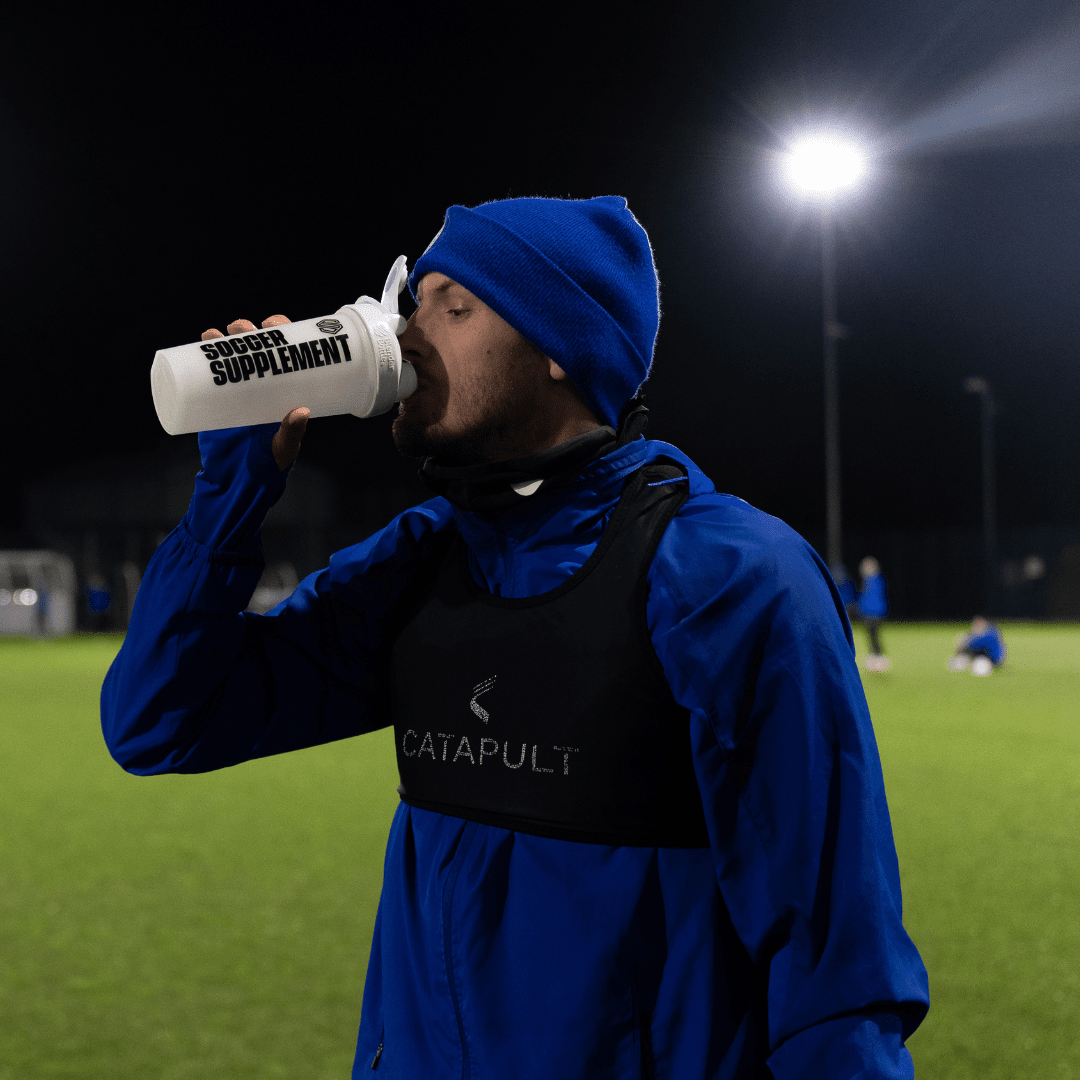Conditioning is a word that didn’t seem to exist in football decades ago – back when pies and pints were more common after a match than ice baths and protein shakes.
Today, every professional football team will have a squad of strength and conditioning coaches ready to keep their players in great shape and performing at the top of their game.
In strength and conditioning, the strength side is pretty self-explanatory – the ability to exert force. So, grabbing a barbell and deadlifting 150kg for a few reps is a good display of strength.
Football conditioning, on the other hand, is a little harder to explain…
What Exactly is Football Conditioning?
Many people assume conditioning is just a fancy word for fitness, and – while there are fitness elements to it – these two ideas differ.
Fitness is about creating the potential for performance, by developing a high aerobic capacity, low resting heart rate, high VO2 max, and so on.
Conditioning is about preparing the player’s body and mind to achieve this potential, as well as improving recovery times and resistance to injury, allowing them to meet the tough demands of the game, especially at top levels.
This means that while a footballer could be very fit, they could also be poorly conditioned at the same time. In theory, they may have the fitness to last 90+ minutes, but actually gas out after 60. This is why teams now put a lot of focus on the football conditioning side of their training.
So, what exactly does football conditioning look like?
Think of it as a skill. Conditioning is a mix of controlling and cultivating good:
- Energy expenditure
- Recovery and respiration
- Joint mobility and integrity
- Mental performance
- Nutrition
Together, developing these physical, mental and lifestyle aspects, a player will be better conditioned for football.
How to Condition Yourself for Football
While more and more amateur teams are employing the services of strength and conditioning coaches, Sunday league players will often have to condition themselves.
Here is a rundown of each aspect of conditioning and how you can develop it to enhance your own game:
Energy Control
When you play and train for football, the only way to do it is by giving 100% effort, 100% of the time… right?
Wrong!
Not even N’Golo Kante can maintain maximum output for the duration of a game. Good conditioning is about being able to effectively utilise and manage your energy. This means not going at full throttle constantly, which can result in high stress, decreased performance and greater injury risk.
Instead, you should practice dynamic energy control. In football, this boils down to working smarter, not harder. In other words, choosing your battles and ensuring you still have something in the tank as you approach the final whistle.
Cultivating good dynamic energy control is about practice and awareness. Being able to tune into your body and know where you are in your exertion will allow you to back off when you don’t need to be giving such effort. This will allow you to better manage fatigue and energy.
In practice this may look like wearing a heart rate monitor during training and understanding what different levels of exertion feel like. Training with a heart rate monitor will allow you to better understand the feeling of being at 50%, 80% or 100% of your effort. This will enable you to make better decisions in a game situation to sustain your energy and avoid early fatigue.
Joint Conditioning
A second layer to the conditioning cake is joint mobility. You can be the fittest player on the pitch, but the moment you begin to feel pain in your knees, shins or ankles, you will start looking towards the bench.
This pain is a sign of poor joint integrity, which is unsurprisingly common. Running is a high-impact activity and repeated running – even on grass – will cause a huge stress on your joints.
To condition your joints, you can focus on adding aerobic plyometrics to your training. Movement such as squat jumps, box jumps, and jumping lunges all help to train the joints in our lower body to become stronger, more elastic and better resistant to the stress caused by the impact of running and jumping.
If you already have issues with joint mobility or integrity, then consult a physio or personal trainer for more detailed guidance.
Recovery and Respiration
Good recovery is essential for top conditioning. There are many things we can do to aid recovery, but in those slower moments during a game or after a lot of exertion, the most important thing we can do is to learn to breathe effectively.
Tying into energy control, the aim of effective breathing is to reduce our heart rate to a recovery state, which allows you to make the most of those short breaks and be able to give full effort again when you need to.
This means that you have to train your respiration to be more effective, using recovery breathing drills. Specific movements go beyond the scope of this guide, but a quick search for ‘belly breathing’ will teach you how to expand your diaphragm and fully inflate your lungs, for optimum recovery during a match.
As for after the match, you can read our complete guide to recovery here.
Mental Performance
Football is as much a mental game as it is physical. You can have perfect energy control and strong joint mobility, but if you crack under pressure, things are unlikely to go your way. This means you also have to condition your mind as much as you do your body.
One way to do this is to perform visualization techniques. For example, when you aren’t training you can sit and imagine yourself playing football well – executing all your tasks perfectly. As a keeper, you can mentally practice saving penalties or winning the ball in packed box. As an attacker, you can imagine creating chances, leaping for a header, or scoring a match-winning free kick.
It may sound a little strange if you haven’t done it before, but visualising everything that could happen during a match and how you would respond is a powerful technique.
In addition to visualisation, it is worth looking at using other techniques to control your emotions before a match. For example, using meditation or relaxation breathing techniques to relax yourself, control anxiety, and focus on the game before kick-off.
If you really take it seriously, you can consult a sports psychologist who can help you overcome obstructive issues such as confidence, frustration, fear and overthinking.
Nutrition
An often-forgotten aspect of conditioning is what goes into your body – in other words, nutrition.
Nutrition can be a simple way to maximize your conditioning and should never be overlooked. Why? Because your level of nutrition is the foundation for your fitness and performance on the pitch. You can work as hard as you like in the gym and on the training field, but if you try to live on a low-carb diet or start a match in a dehydrated state, then you are building your game on a very shaky foundation.
Therefore, creating an effective fuelling strategy underpins everything else. We have many articles on this, including one on how to fuel for Sunday league football.
However, in a nutshell, carbs and hydration should be your focus on a matchday. This means eating a meal containing quality carbohydrates – such as porridge, pasta, bread or cereal – around 2 to 3 hours before the match, and drinking at least 500ml to 1 litre of water in the build up to the match.
Just before the match you can start adding supplements to help enhance your performance. For example, our Fuel90® energy gel gives you an effective energy and hydration boost before the match. It offers a blend of two carbohydrate sources and 380mg of electrolytes in a convenient gel sachet that’s easy to chuck in your kitbag.
Don’t forget to recover properly after the match. Taking a quality protein supplement and some fruit soon after the final whistle will kickstart your recovery and give your muscles everything they need to start rebuilding. You can also try our all-in-one recovery drink, Recover90®, which provides key doses of protein, carbohydrates and electrolytes to stimulate muscle repair and encourage hydration.


As you can see, with conditioning, everything ties into everything else. You need to cultivate good joint mobility, recovery, energy control and mental fortitude, all underpinned by good nutrition. If one aspect fails, chances are you won’t be able to perform to your potential.
You can follow some of the advice here, although if you are serious about the wide world of conditioning, it is wise to speak to a qualified strength and conditioning coach – whether someone employed by your team or by hiring someone independently (as you would a personal trainer).
A good conditioning coach will construct a bulletproof plan to enable you to perform to your full potential come Saturday afternoon and beyond!
Shop our range of protein powders, energy gels and hydration tablets and become the best version of yourself on the pitch.







